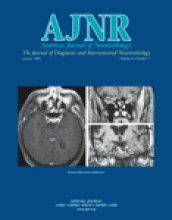Abstract
BACKGROUND AND PURPOSE: We hypothesize that the nearly doubling of signal-to-noise ratio at 3.0 T compared with that at 1.5 T yields improved clinical MR angiograms and enables superior visualization of intracranial aneurysms. The goal of this study was to determine whether 3.0-T time-of-flight (TOF) MR angiography is superior to 1.5-T TOF MR angiography in the detection and characterization of intracranial aneurysms.
METHODS: Fifty consecutive patients referred for MR angiography of a known or suspected intracranial aneurysm underwent 3-T TOF MR angiography. Seventeen of these 50 patients had also previously undergone 1.5-T TOF MR angiography and these images were used as a basis for comparison with images obtained at 3.0 T. Fourteen of 23 patients in whom aneurysms were identified also underwent prior conventional angiography, which was used as the reference standard. Readers blinded to patient history identified the presence and location of aneurysm(s) on angiograms and graded images for overall image quality by using a five-point scale.
RESULTS: Twenty-eight aneurysms were identified in 23 of 50 patients. Seventeen aneurysms in 17 patients had been documented with 1.5-T MR angiography. The 3.0-T technique had a higher mean image quality score than that of the 1.5-T MR technique (P < .0001). Both 3.0-T and 1.5-T TOF MR angiography depicted all the aneurysms that had been documented by conventional angiography.
CONCLUSION: 3D TOF MR angiography at 3 T offers superior depiction of intracranial aneurysms compared with that of 1.5-T TOF MR angiography.
- Copyright © American Society of Neuroradiology












